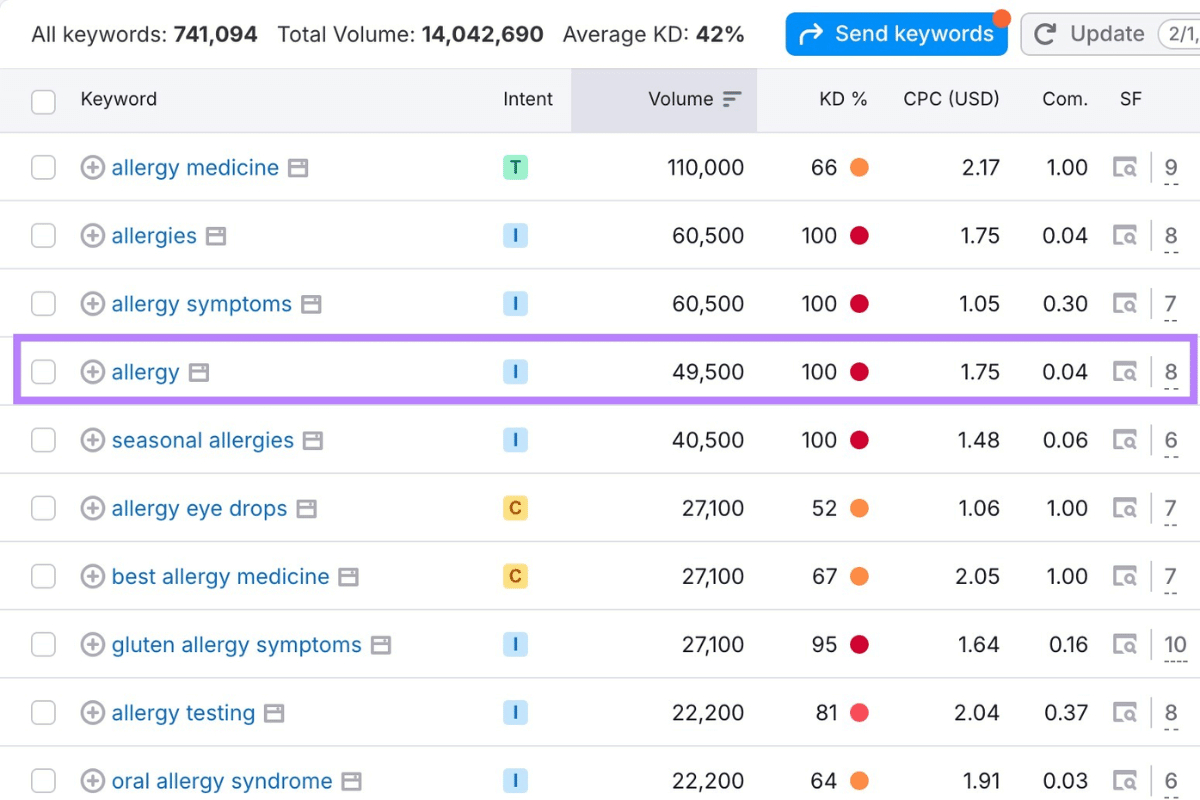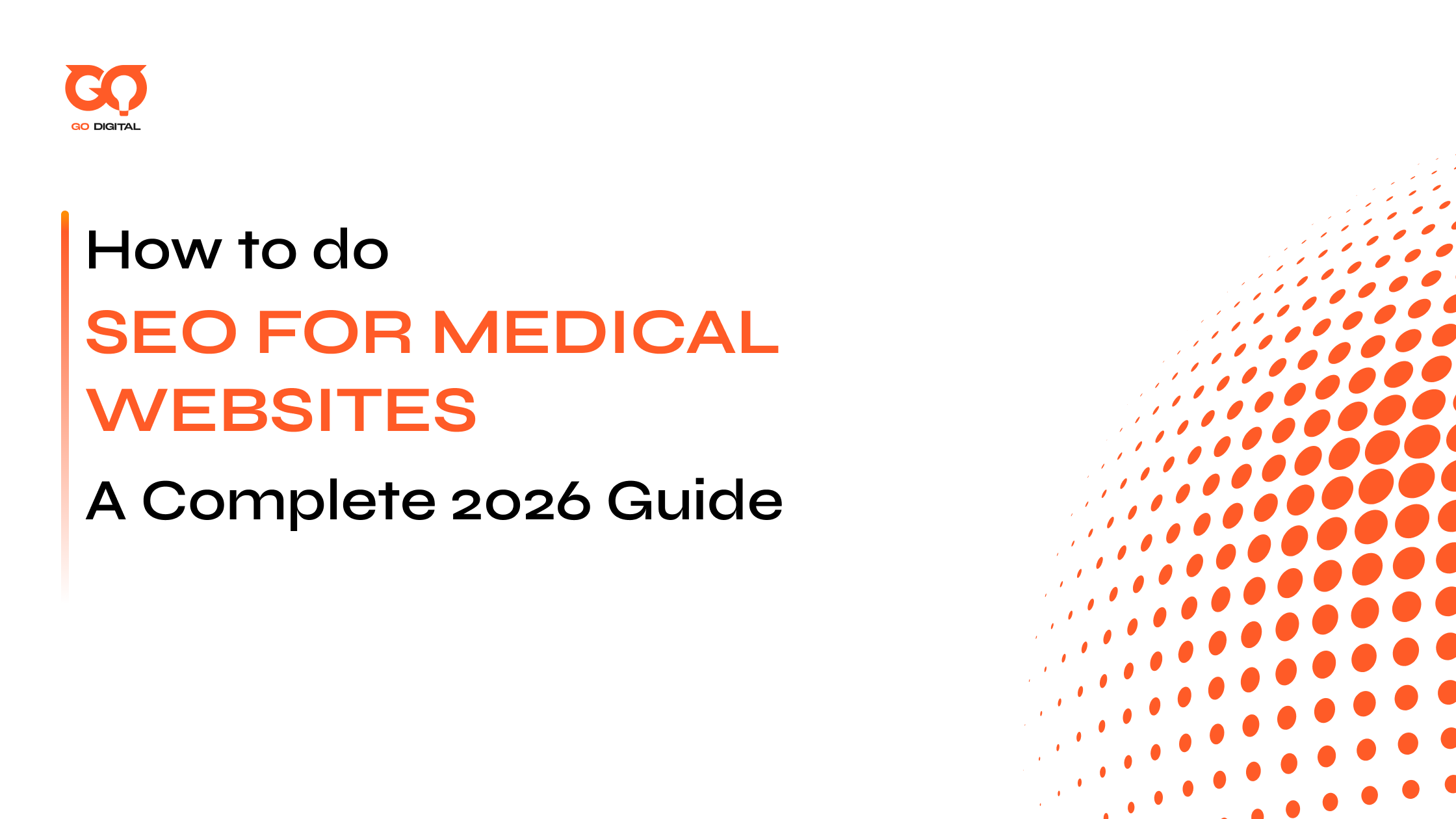If you run a clinic or healthcare practice, getting noticed online is no longer optional. SEO for medical websites helps patients find you, builds trust, and keeps your practice competitive in 2025. In this guide, we’ll cover everything you need to know—step by step.
Key takeaways:
|
Why SEO Matters for Medical Websites in 2025
Healthcare search behavior has shifted quickly. In 2025, more than 75% of patients research symptoms, clinics, or doctors online before making an appointment. Google also continues to refine how it ranks medical information, favoring sites with expertise, trust, and clean user experience.

Importance of SEO for medical websites 2025
Without proper SEO, even the best clinic will struggle to reach patients—especially when competitors are investing heavily in online visibility.
For example: A small dermatology clinic in Chicago optimized their website for keywords like “eczema treatment near me” and “Chicago skin clinic.” Within 4 months, their website traffic increased by 60%, and they received 35% more appointment bookings through Google search alone.
In total, SEO is more than just traffic, it builds credibility. Patients trust websites that appear at the top of search results, so a strong SEO for medical websites strategy helps position your clinic as a reliable healthcare provider.
Benefits of SEO for Medical Websites

Key benefits of SEO for healthcare websites
- Increased visibility: Appear on Google when patients search for services. A dental clinic that ranks first for “emergency dentist Chicago” can see a substantial increase in appointments.
- More appointments: Higher search rankings translate into more clicks and calls. For example, an orthopedic clinic doubled appointment requests after updating its service pages with SEO best practices.
- Local authority: Local SEO positions your clinic as a trusted nearby option. Patients often choose providers within a few miles.
- Patient trust: Informative, accurate content builds credibility and reassures patients. Well-written blogs on conditions like diabetes or hypertension help patients make informed decisions.
- Cost-effective marketing: Organic search reduces reliance on paid ads, making it a long-term, cost-efficient strategy for clinics of any size.
Step-by-Step SEO Strategy for Medical Websites
Keyword Research for Medical SEO
Keyword research is the foundation of medical SEO. Focus on what patients actually type into search engines. Use tools like Ahrefs, SEMRush, and Google Keyword Planner.

Finding the right keywords for healthcare websites
Tips and examples:
- Service-specific terms: “pediatric dentist near me,” “cosmetic dentist Chicago”
- Condition/treatment-based keywords: “migraine treatment clinic,” “arthritis therapy center”
- Localized keywords: “family doctor in Austin”
Always consider search intent. Someone searching for “flu symptoms” wants information, while “flu vaccine near me” indicates a booking intent. Target both types of searches strategically.
Example: A cardiology clinic created content around “heart attack symptoms,” and then added localized service pages like “cardiologist near downtown Boston.” The combination increased both traffic and appointment conversions.
Writing SEO-Friendly Medical Content
Patients want clear, trustworthy information. Good content establishes authority and helps your website rank higher.
Guidelines:
- Avoid excessive jargon; explain terms simply. For instance, say “high blood pressure” instead of “hypertension” for general blog posts.
- Answer common patient questions: “What to expect during a colonoscopy?”
- Include keywords naturally, avoiding stuffing.
- Use headings, bullet points, images, and infographics for readability.
Case in point: A small dermatology clinic wrote a detailed guide on “eczema treatment for adults,” combining keywords, images, and FAQ sections. They saw a 40% increase in blog traffic within three months.
Building Trust Through YMYL & E-E-A-T for Medical SEO
Medical websites fall under Google’s YMYL (Your Money Your Life) category, meaning the content can directly impact a patient’s health, safety, or well-being. Because of this, Google places much higher demands on accuracy, trustworthiness, and transparency.
To rank well, your content must demonstrate strong E-E-A-T:
- Experience: Real-world clinical experience or practitioner insights.
- Expertise: Credentials, certifications, or subject-matter authority.
- Authoritativeness: Recognition from reputable healthcare organizations.
- Trustworthiness: Accurate, evidence-based, medically reviewed content.
Ways to show E-E-A-T on a medical website:
- Add author bios with relevant titles (e.g., MD, DO, RN, DPT).
- Mention years of clinical experience (e.g., “10+ years in orthopedic surgery”).
- Include citations from verified sources like Mayo Clinic or CDC.
- Add a “Medically Reviewed By” section.
- Publish clear disclaimers: “Content is for informational purposes only.”
Example: A clinic publishes an article on “Early Signs of a Stroke.” The author is Dr. Jane Patel, Board-Certified Neurologist. The content is reviewed by Dr. Robert Lin, Senior Stroke Specialist. A footer note states: “Medically reviewed for accuracy in September 2025.”
→ This level of transparency not only improves rankings but also boosts patient trust.
On-Page SEO Optimization

Optimizing web pages for better search rankings
Each page should be optimized for search engines and patients:
- Title tags & meta descriptions: Include primary keywords. Example: “Migraine Treatment Clinic in New York – ABC Neurology”
- Header tags (H1, H2, H3): Structure content to make it scannable.
- Internal linking: Connect blogs and service pages to guide readers naturally.
- Image alt text: Describe procedures or staff photos, e.g., “Dr. Smith performing ultrasound on patient.”
For example: A dental clinic optimized all images, titles, and meta descriptions. This led to a 25% increase in traffic from image search alone.
Technical SEO for Healthcare Websites
Technical SEO ensures your site is fast, secure, and easy to navigate:
- Mobile-friendly design: Many patients book appointments via mobile.
- HTTPS encryption: Secure patient data is critical.
- Fast loading times: Patients leave slow websites.
- Structured data (schema markup): Helps search engines understand your content. For example, a clinic can mark up doctor profiles, treatments, and reviews for rich snippets.
Case study: A physical therapy clinic optimized site speed and added structured data. Within 2 months, they saw better visibility in Google snippets and increased appointment requests.
Local SEO for Clinics and Practitioners

Improving local search presence for clinics
Local SEO is vital for attracting nearby patients:
- Claim Google Business Profile: Add clinic hours, photos, and services.
- NAP consistency: Ensure Name, Address, Phone are uniform across directories.
- Patient reviews: Encourage happy patients to leave reviews.
- Location-based keywords: Include city names naturally in content.
Example: A small eye clinic in Houston focused on “eye exams near Houston”. After optimizing their local listings and collecting reviews, they moved to the top 3 results in local searches within 3 months.
Off-Page SEO and Link Building
External links increase your website’s authority:
- Guest posts on reputable healthcare blogs
- Collaboration with local health organizations
- Mentions in news articles
- Backlinks from directories like Healthgrades or WebMD
Example: A dental clinic gained a backlink from a local lifestyle magazine by contributing an article on “Oral Health Tips for Kids.” This referral link improved their domain authority and search rankings.
Marketing & Automation Enhancements

Using automation and marketing to support SEO
Improving your medical SEO isn’t just about ranking higher—it’s also about creating smoother, more engaging patient experiences. Marketing automation helps clinics save time, reduce manual tasks, and stay connected with patients in a way that feels natural and professional.
- Automation Review Request (SMS / Email – HIPAA-Compliant): Online reviews matter more than ever. For clinics, a simple, timely follow-up message can increase review volume dramatically while keeping everything HIPAA-compliant.
- Online Appointment Booking Tools: Patients expect quick, convenient scheduling. An online booking system, available 24/7, removes friction and increases conversions.
- Social Media Content & Patient Engagement Automation: Consistent social media activity boosts trust, improves brand awareness, and indirectly supports SEO by increasing branded searches.
For example: A pediatric clinic scheduled 20 posts per month using a social scheduler. Their engagement doubled, and website traffic from social networks increased by nearly 60%.
Monitoring and Improving SEO Performance
Keeping your medical website visible on Google isn’t a one-time task — it requires ongoing monitoring and thoughtful adjustments.
![]()
Tracking and refining website SEO results
One of the best ways to stay on track is by using tools like Google Analytics and Google Search Console. These platforms show how people find your site, what pages they interact with, and where they decide to leave. With this information, you can spot patterns and identify opportunities for improvement.
- Monitor traffic, keyword rankings, and conversions to understand which services attract the most interest and where potential patients drop off.
- Identify underperforming pages that aren’t receiving clicks, have high bounce rates, or provide outdated medical information.
- Update content regularly to keep it accurate, relevant, and aligned with the latest health guidelines. Fresh content signals to Google that your clinic is active and trustworthy.
Example: A clinic noticed low engagement on their “Diabetes Management” page. They updated the content with latest treatment tips and added patient stories, boosting traffic by 50% in 2 months.
Common SEO Mistakes Healthcare Websites Make
Many healthcare websites struggle with SEO not because they lack good services, but because of small yet impactful mistakes. Understanding these issues helps clinics make better choices and avoid losing visibility on Google.
- Publishing overly technical or complicated medical content that patients cannot understand.
- Ignoring local SEO essentials such as Google Business Profile, reviews, and consistent NAP information.
- Allowing treatment pages or medical blogs to become outdated.
- Forgetting to add clear calls to action like “Book an appointment” or “Call now.”
- Letting technical errors remain: slow loading pages, no SSL, poor mobile experience, broken links.
- Copying content from other medical websites or posting AI-generated text without editing.
- Lacking high-quality backlinks from reputable health or local sources.
Avoiding these mistakes helps maintain visibility, credibility, and patient trust.
SEO Tools Every Healthcare Marketer Should Know
Choosing the right tools makes it easier to optimize a healthcare website, track performance, and spot new growth opportunities. Below is a clear breakdown of the tools worth using and what they help you achieve.
| Tool | What It Helps With |
| Google Search Console | Monitors search performance, indexing issues, and keyword impressions. |
| Google Analytics 4 | Tracks user behavior, session time, page engagement, and conversions. |
| Ahrefs / Semrush | Provides keyword research, competitor insights, and backlink analysis. |
| SurferSEO / Frase | Supports content optimization based on top-ranking healthcare pages. |
| Screaming Frog | Detects technical issues like broken links, duplicate pages, missing metadata. |
| PageSpeed Insights | Evaluates website speed and gives recommendations for faster loading. |
| Moz Local / BrightLocal | Improves local SEO consistency across directories and citations. |
Tip: Combine multiple tools for a complete picture of your SEO health.
Bottom Line
SEO for medical websites is critical in 2025. By combining technical SEO, local optimization, content marketing, and off-page strategies, your clinic can attract more patients, establish trust, and outperform competitors. SEO is ongoing – start small, track progress, and refine your approach for long-term results.
If you want a team that understands healthcare SEO and knows how to turn your website into a patient-booking machine, Golden Own Digital is here to help. From strategy to implementation, we create SEO systems that work for clinics, doctors, and healthcare brands of all sizes.
Ready to grow your medical practice online? Let Golden Own Digital take your SEO to the next level.
FAQ
Q1: How long does medical SEO take to show results?
Typically, you will start seeing significant traction from a comprehensive seo for medical website strategy within 4 to 6 months, though initial improvements in local rankings can appear faster (1-3 months). Full dominance takes 12+ months.
Q2: Is local SEO more important for clinics than hospitals?
Yes. Clinics rely heavily on nearby patients. Local SEO ensures patients in your city can find you quickly.
Q3: What’s the difference between healthcare SEO and regular SEO?
The main difference is the high stakes of E-A-T (Expertise, Authoritativeness, Trustworthiness). Because healthcare falls under Google’s YMYL (Your Money or Your Life) category, medical websites face far stricter quality guidelines than regular business websites.
Q4: Can small clinics compete with large hospital websites?
Absolutely. Focused local SEO, targeted content, and patient engagement can outperform large hospitals in local searches.
Q5: How is SEO used in healthcare?
SEO in healthcare is used to attract new patients, drive awareness for specific medical services (e.g., telehealth, new technologies), recruit staff, and establish the organization as a trusted resource for health information.
Q6: What is local SEO for doctors?
Local SEO for doctors is the process of optimizing a doctor’s online presence to rank higher in Google’s localized search results. It focuses heavily on maximizing the Google Business Profile, accumulating geographic-specific reviews, and ensuring consistent NAP information across all online directories.

Jaden is an SEO Specialist at Golden Owl Digital. He helps brands rank higher with technical SEO and content that resonates






